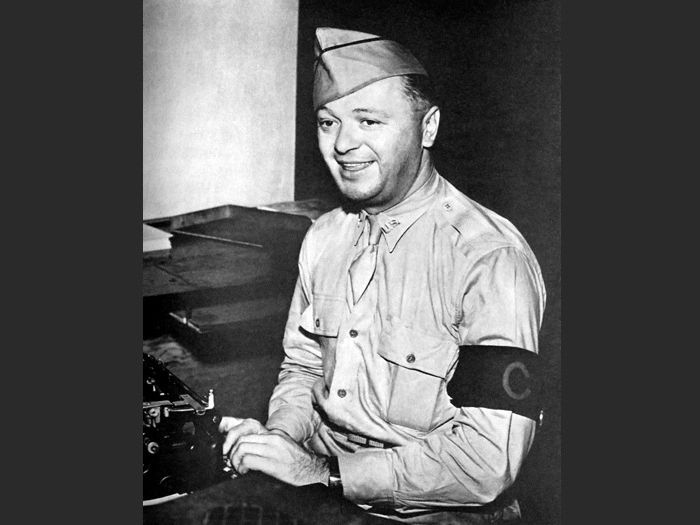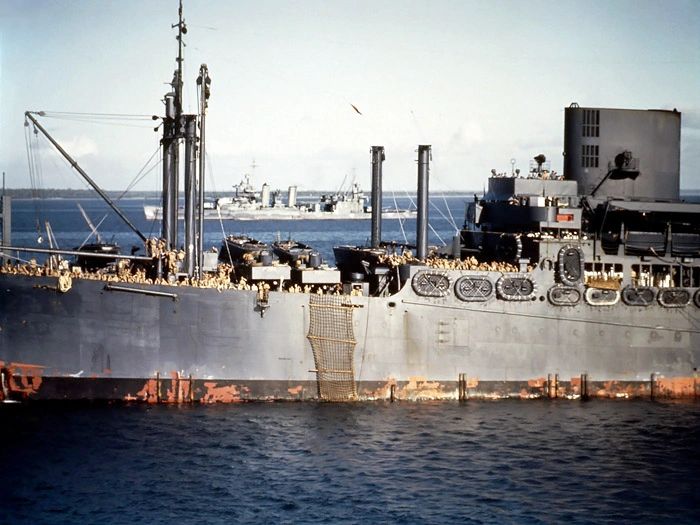USS ASTORIA CA-34
The Official Home of 'Nasty Asty'
Offensive Preparations
July-August 1942

CLICK PHOTO TO ENLARGE
USS ASTORIA CA-34 moored in berth C-3 at Pearl Harbor circa 1-7 July 1942. A new Mk 3 main battery fire control radar has been attached to her forward Mk 38 director. She has also been fitted with blast bags for the first time during the war. The number two turret blast bag has not yet been painted to match her Measure 21 camouflage. This is the only color photograph of ASTORIA CA-34 known to this website. MINNEAPOLIS CA-36 is moored to starboard.
-U.S. Navy photo from NARA collection 80-G-K-452
On 14 June 1942, the day after ASTORIA returned to Pearl Harbor, she underwent a Change of Command Ceremony. CAPT William G. Greenman relieved Francis W. Scanland as 7th commanding officer of the ship. At this time ASTORIA also received upgrades including the addition of new main battery fire control radar and blast bags for her 8" rifles.
After three weeks of refit and at Pearl Harbor, ASTORIA stood out again on 7 July. She sailed in company of Task Force 11 built around USS SARATOGA CV-3. The general consensus among the men was that this was to be a short training run in the vicinity of Hawaii. In reality, Task Force 11 was one of three carrier task forces converging in preparation for America's first offensive of the war.

ASTORIA sailed for the offensive with one civilian aboard--UPI press correspondent Joe J. Custer. Based in Hawaii, Custer had been present for the Japanese attacks on Oahu. He subsequently covered the Doolittle Raid and the Battle of Midway from other Pacific Fleet ships.
-UPI photo reprinted from Custer, Through the Perilous Night
On 8 July, the day after steaming from Pearl Harbor, Task Force 11 stood off the Kona coast of the island of Hawaii. UPI correspondent Joe Custer wrote:
Order of the day: "Bombardment, using live ammunition; simulating invasion of enemy island, in coordination with carrier planes." That was the tip-off on our mission; we were in on America's first offensive in World War II--bombardment and invasion.

CLICK PHOTO TO ENLARGE
The aft main battery of ASTORIA CA-34 fires during the simulated bombardment of Kona on 8 July, 1942. Note that her catapults and well deck are empty--her floatplanes are overhead providing gunfire spotting.
-U.S. Navy photo from NARA collection 19-LCM
Custer observed the fire alongside Bill Truesdell, the ship's Gunnery Officer, from the director platform atop Sky Control. He wrote:
Truesdell was pleased with our accuracy in the drill; the "Nasty" had a reputation to uphold--she was acknowledged one of the best-shootin' ships in the Navy. Her AA gunners proudly pointed to the miniature Japanese flags painted on their steel gun shields, "notches" for the planes they had bagged.
Directly beneath Sky Control, the port 20-millimeter showed six Rising Suns, the starboard shield, five. There was keen rivalry between the two crews.

CLICK PHOTO TO ENLARGE
Above and below: Following the gunnery practice on 8 July, ASTORIA CA-34 recovers one of her SOC floatplanes to starboard. Note the port plane has already been recovered. Also note that the blast bags on her number three turret have not yet been painted.
-U.S. Navy photo from Brent Jones collection

CLICK PHOTO TO ENLARGE
-U.S. Navy photo from NARA collection 19-LCM

CLICK PHOTO TO ENLARGE
Ships of Task Force 11 in formation off Hawaii circa 8 July 1942. Front to back: USS ASTORIA CA-34, VINCENNES CA-44, MINNEAPOLIS CA-36, NEW ORLEANS CA-32, and six DDs.
-U.S. Navy photo from Brent Jones collection
Following the gunnery exercises off Hawaii, Task Force 11 headed south. When the ships crossed the equator on Sunday 12 July, wartime conditions did not prevent a time-honored maritime tradition: the Crossing of the Line ceremonies. First-time "polywogs," Custer included, were inducted into the Royal Order of Trusty Shellbacks by veteran sailors who had previously crossed. "Induction" meant any variety of indignities and abuses--hazing of the highest order.

CLICK PHOTO TO ENLARGE
Perhaps the rarest of ASTORIA CA-34 artifacts. Following the line crossing ceremony, new Trusty Shellbacks were awarded Neptunus Rex certificates commemorating the event. S2/c Chester W. Johnson folded his certificate up and mailed it home just days before the ship took part in the Guadalcanal landings. As a result, this original certificate is one of perhaps a handful (or fewer) that survived the battle. Johnson was wounded but also survived. Note that the certificate displays an inaccurate date and longitude which would have placed ASTORIA off the east coast of Brazil, a measure taken to ensure the certificate did not divulge confidential ship movement information.
-U.S. Navy photo from Brent Jones collection
UPI Correspondent Joe Custer wrote:
We had the word early, on the ASTORIA: We were to join other task forces at sea, to form the largest wartime Naval force in our history. A total of more than fifty major ships--staggering to us. At Wake and Marcus we had ten; on the Doolittle raid, perhaps two dozen. But fifty ships! A sizeable force indeed; you could get plenty of places with that.
The actual number of ships converging was 76. Three carrier task forces, built around USS SARATOGA, ENTERPRISE and WASP were to meet up with a large number of attack transports with the 1st Marine Division embarked. Their objectives: Tulagi and Guadalcanal in the Solomon Islands, a strategic site for airfields in the hands of whichever combatant force held them. In July 1942, they were in Japanese control.

CLICK PHOTO TO ENLARGE
Heavy cruiser USS QUINCY CA-39 anchored in Nuku'alofa Harbor, Tongatapu, Tonga Islands circa 18-23 July 1942. Tongatapu was the final stop for Task Force 18 prior to rendezvous with the two other Carrier Task Forces at Fiji. This color photograph sequence was taken from USS WASP CV-7.
-U.S. Navy photo in NARA collection 80-G-K-563

CLICK PHOTO TO ENLARGE
Light cruiser (anti-aircraft) USS SAN JUAN CL-54 in Nuku'alofa Harbor circa 18-23 July 1942.
-U.S. Navy photo in NARA collection 80-G-K-555

CLICK PHOTO TO ENLARGE
USS QUINCY CA-39 off the starboard beam of PRESIDENT ADAMS AP-38 on 21 July 1942.
-U.S. Navy photo in NARA collection 80-G-K-554

CLICK PHOTO TO ENLARGE
USS PRESIDENT ADAMS AP-38 in Nuku'alofa Harbor, Tongatapu on 21 July 1942. First Division Marines line the rails. The cruiser in the background is USS BOISE CL-47 making a brief stop on her way to Pearl Harbor.
-U.S. Navy photo in NARA collection 80-G-K-556

CLICK PHOTO TO ENLARGE
USS BARKER DD-213 also makes a brief refueling stop on 21 July 1942. In the background USS PRESIDENT JACKSON AP-37, another transport bound for the invasion, takes an oiler alongside.
-U.S. Navy photo in NARA collection 80-G-K-559

CLICK PHOTO TO ENLARGE
BARKER DD-213 approaches oiler KANAWHA AO-1 on 21 July 1942. At right is SAN JUAN CL-54.
-U.S. Navy photo in NARA collection 80-G-K-526

CLICK PHOTO TO ENLARGE
USS BUCHANAN DD-484 underway circa July 1942.
-U.S. Navy photo in NARA collection 80-G-K-421

CLICK PHOTO TO ENLARGE
HMAS CANBERRA circa July 1942. A Royal Australian Navy whaleboat crosses between CANBERRA and HMAS AUSTRALIA, the source of the photograph.
-RAN photo from Brent Jones collection.
The large groups of ships rendezvoused in the Fiji Islands to reassign and prepare for the invasion, codenamed Operation WATCHTOWER. USS ASTORIA was among the first to arrive and ended up marking time at anchor for a week. Due to the lack of replenishment options, ASTORIA's crew had to closely ration food and water during this period.
Once the remaining fleet elements assembled, rehearsal exercises took place at Koro Island in the heart of the Fiji chain, where preparations could be kept secret. The rehearsal, codenamed Operation DOVETAIL, was problematic and lacked coordination.

CLICK PHOTO TO ENLARGE
HMAS AUSTRALIA with guns trained to starboard in a photograph likely taken during rehearsal Operation Dovetail off Koro, circa 28-31 July 1942. The guns in the foreground are from the light cruiser HMAS HOBART, source of the image. Royal Australian Navy photography accounts for a significant contribution to images from Operation WATCHTOWER.
-RAN photo from Brent Jones collection.

CLICK PHOTO TO ENLARGE
The Australian colors flying over HMAS HOBART during the rehearsal exercises in the Fiji Islands.
-RAN photo from Brent Jones collection.

CLICK PHOTO TO ENLARGE
USS NEW ORLEANS CA-32 (foreground) and ASTORIA CA-34 during Operation DOVETAIL maneuvers off Fiji in late July 1942. Note that both ships are recovering floatplanes to starboard.
-U.S. Navy photo from Brent Jones collection

CLICK PHOTO TO ENLARGE
An American BAGLEY-class destroyer alongside HMAS HOBART to transfer mail and supplies in rough seas. All eight BAGLEY-class DDs participated in Operation WATCHTOWER.
-RAN photo from Brent Jones collection.

The route taken by the combined American-Australian task forces en route to Guadalcanal in early August 1942, following the completion of rehearsals at Koro.
-manipulated from Google Earth imagery

CLICK PHOTO TO ENLARGE
Light cruiser (anti-aircraft) USS SAN JUAN CL-54.
-RAN photo from Brent Jones collection.

CLICK PHOTO TO ENLARGE
Above: USS SARATOGA CV-3 underway for Operation WATCHTOWER.
Below: ENTERPRISE CV-6 from the same vantage point aboard HMAS AUSTRALIA.
-RAN photos from Brent Jones collection.

CLICK PHOTO TO ENLARGE

CLICK PHOTO TO ENLARGE
HMAS HOBART from AUSTRALIA in heavy overcast. These two ships were responsible for a large contribution of the surviving photography from Operation WATCHTOWER.
-RAN photo from Brent Jones collection.

CLICK PHOTO TO ENLARGE
Starboard bow view of VINCENNES CA-44 in modified Measure 12 camouflage.
-RAN photo from Brent Jones collection.

ASTORIA CA-34 as the Allied force approaches the Solomon Islands, 6 August 1942. The next morning she and her sister cruisers would provide shore bombardment for the Marines going ashore at Guadalcanal and Tulagi.
-U.S. Navy photo in NARA collection 80-G-013477
Continue to OPERATION WATCHTOWER

Sources
Custer, Joe James. Through the Perilous Night: The Astoria's Last Battle. New York, NY: The MacMillan Company, 1944.
Domagalski, John J. Lost at Guadalcanal. Jefferson, NC: McFarland & Company Inc., 2010.
Google Earth. earth.google.com/download-earth.html.
Jones, Brent. Private photo and document collection.
Jones, Pat (ed.) The USS ASTORIA (CA-34) and the Men Who Sailed Her. USS ASTORIA Reunion Association. Privately printed, 1992.
National Archives and Records Administration. http://www.archives.gov/research/
NavSource Navy Historical Photograph Database. http://www.navsource.org/
Wiemer, Robert S. Private photo and document collection.
BACK TO USS ASTORIA HOMEPAGE
